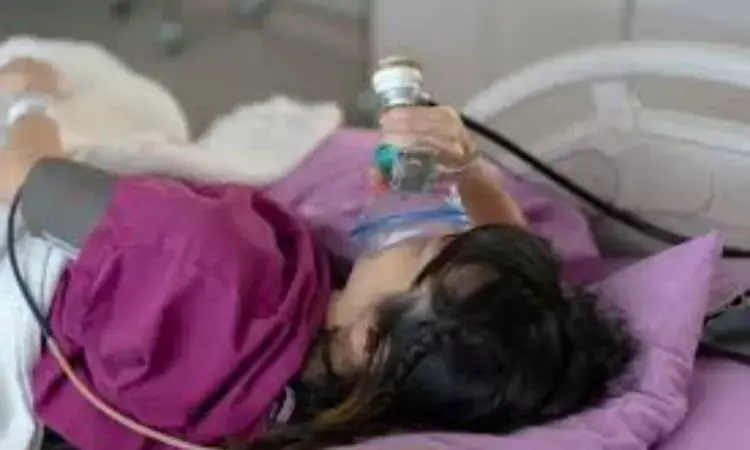- Home
- Medical news & Guidelines
- Anesthesiology
- Cardiology and CTVS
- Critical Care
- Dentistry
- Dermatology
- Diabetes and Endocrinology
- ENT
- Gastroenterology
- Medicine
- Nephrology
- Neurology
- Obstretics-Gynaecology
- Oncology
- Ophthalmology
- Orthopaedics
- Pediatrics-Neonatology
- Psychiatry
- Pulmonology
- Radiology
- Surgery
- Urology
- Laboratory Medicine
- Diet
- Nursing
- Paramedical
- Physiotherapy
- Health news
- Fact Check
- Bone Health Fact Check
- Brain Health Fact Check
- Cancer Related Fact Check
- Child Care Fact Check
- Dental and oral health fact check
- Diabetes and metabolic health fact check
- Diet and Nutrition Fact Check
- Eye and ENT Care Fact Check
- Fitness fact check
- Gut health fact check
- Heart health fact check
- Kidney health fact check
- Medical education fact check
- Men's health fact check
- Respiratory fact check
- Skin and hair care fact check
- Vaccine and Immunization fact check
- Women's health fact check
- AYUSH
- State News
- Andaman and Nicobar Islands
- Andhra Pradesh
- Arunachal Pradesh
- Assam
- Bihar
- Chandigarh
- Chattisgarh
- Dadra and Nagar Haveli
- Daman and Diu
- Delhi
- Goa
- Gujarat
- Haryana
- Himachal Pradesh
- Jammu & Kashmir
- Jharkhand
- Karnataka
- Kerala
- Ladakh
- Lakshadweep
- Madhya Pradesh
- Maharashtra
- Manipur
- Meghalaya
- Mizoram
- Nagaland
- Odisha
- Puducherry
- Punjab
- Rajasthan
- Sikkim
- Tamil Nadu
- Telangana
- Tripura
- Uttar Pradesh
- Uttrakhand
- West Bengal
- Medical Education
- Industry
Inhaled nitrous oxide beneficial for IV insertions and laceration repair in children and youth

Canada: A meta-analysis has shown that nitrous oxide (N2O) is beneficial for laceration repair and intravenous (IV) insertion in children as young as 1-year-old. It can be recommended over oral midazolam for reducing distress and pain in children undergoing laceration repair and IV insertions.
"Evidence is sufficient to recommend N2O plus topical anaesthetic for laceration repair and IV insertions," researchers wrote in their study published in the Canadian Journal of Emergency Medicine. "Adverse effects are higher when combined with other sedating agents."
Children frequently undergo painful medical procedures in the emergency department (ED). Ketamine and midazolam are the most commonly used sedative anxiolytics in children but have limitations, such as poor intranasal tolerance and variable efficacy (midazolam) and painful needle-related administration (ketamine).
Using inhaled N2O can control these limitations, as it is effective for a brief painful procedure, administered non-invasively, and has an excellent safety profile. It has a rapid onset of peak effect and offset. However, there is an uncertain analgesic benefit for painful procedures, compliance with administration in young children, and the safest concentration. There is potential for greater N2O use in children; however, more extensive evidence is needed to inform providers’ choice of patients, concentration, and indications.
To address this knowledge gap, Naveen Poonai from Schulich School of Medicine and Dentistry in London, ON, Canada, and colleagues aimed to synthesize indication-based evidence for N2O for pain and distress in children.
In the study, trials of N2O in participants 0–21 years, reporting distress or pain for ED procedures, were included. A total of 30 trials were included. The study's primary outcome was procedural distress. Tricco et al.’s classification of “neutral", “favourable,” or “unfavourable” (supporting N2O or comparator, respectively) was used where meta-analysis was not possible.
The researchers reported the following findings:
- For pain using the Visual Analog Scale (0–100 mm) during IV insertions, 70% N2O (delta:-16.5; three trials; I2 = 0%) and 50% N2O plus a eutectic mixture of local anaesthetics (EMLA) (delta:-1.2; two trials; I2 = 43%) were superior to EMLA. 50% N2O was not superior to EMLA (delta:-0.4; two trials; I2 = 15%).
- For distress and pain during laceration repair, N2O was “favourable” versus each of SC lidocaine, oxygen, and oral midazolam but “neutral” versus IV ketamine (five trials).
- For distress and pain during fracture reduction (three trials), N2O was “neutral” versus each of IM meperidine plus promethazine, regional anaesthesia, and IV ketamine plus midazolam.
- For distress and pain during a lumbar puncture (one trial), N2O was “favourable” versus oxygen.
- For distress and pain during urethral catheterization (one trial), N2O was “neutral” versus oral midazolam. For pain during intramuscular injection (one trial), N2O plus EMLA was “favourable” versus N2O and EMLA alone.
- Common adverse effects of N2O included nausea (4.4%), agitation (3.7%), and vomiting (3.6%) AEs were less frequent with N2O alone (24.2%) versus N2O plus midazolam (92.3%) and N2O plus fentanyl (61.2%).
"Our findings support a larger literature body that N2O is effective and safe in children," the research team wrote. "Among trials that used validated instruments for distress and pain, our review indicates that combined with topical anaesthetic, N2O is superior to conventional agents, such as EMLA and midazolam, and can be recommended for laceration repair and IV insertions."
Evidence indicates N2O is safe, even at higher concentrations. It is likely beneficial in children as young as one year old, but experienced providers are required to prevent oversedation using a continuous flow device.
Reference:
Poonai, N., Creene, C., Dobrowlanski, A. et al. Inhaled nitrous oxide for painful procedures in children and youth: a systematic review and meta-analysis. Can J Emerg Med (2023). https://doi.org/10.1007/s43678-023-00507-0
Dr Kamal Kant Kohli-MBBS, DTCD- a chest specialist with more than 30 years of practice and a flair for writing clinical articles, Dr Kamal Kant Kohli joined Medical Dialogues as a Chief Editor of Medical News. Besides writing articles, as an editor, he proofreads and verifies all the medical content published on Medical Dialogues including those coming from journals, studies,medical conferences,guidelines etc. Email: drkohli@medicaldialogues.in. Contact no. 011-43720751


